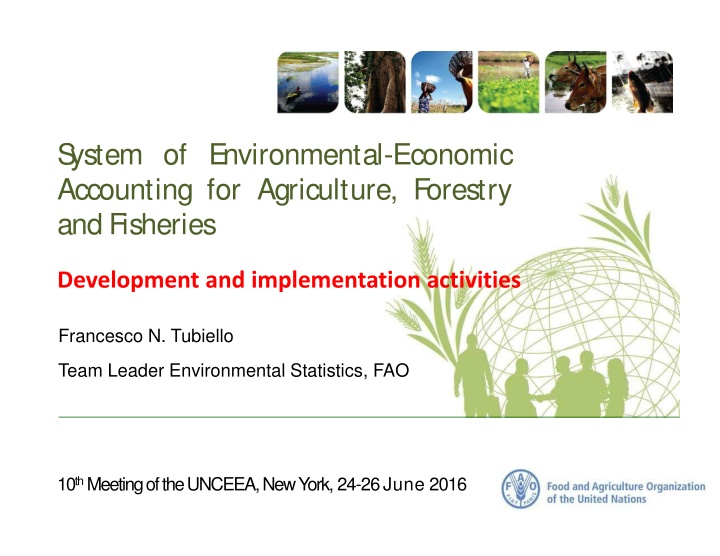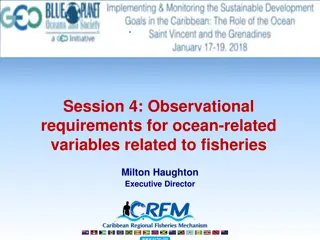Development of System of Environmental-Economic Accounting for Agriculture, Forestry, and Fisheries
The System of Environmental-Economic Accounting for Agriculture, Forestry, and Fisheries (SEEA-Agriculture) initiative by FAO, in collaboration with UNSD, aims to construct relevant accounting tables and assess data availability for sustainable development. Pilot countries include Australia, Canada, Guatemala, and Indonesia. The SEEA-Agriculture draft was discussed at an Expert Group Meeting in 2014, leading to an updated submission to UNSD for global consultation. Future activities include finalizing the revised draft, global consultations, and tiered implementation approaches.
Download Presentation

Please find below an Image/Link to download the presentation.
The content on the website is provided AS IS for your information and personal use only. It may not be sold, licensed, or shared on other websites without obtaining consent from the author.If you encounter any issues during the download, it is possible that the publisher has removed the file from their server.
You are allowed to download the files provided on this website for personal or commercial use, subject to the condition that they are used lawfully. All files are the property of their respective owners.
The content on the website is provided AS IS for your information and personal use only. It may not be sold, licensed, or shared on other websites without obtaining consent from the author.
E N D
Presentation Transcript
S ystem of Environmental-Economic Accounting for Agriculture, Forestry andFisheries Development and implementation activities Francesco N. Tubiello Team Leader Environmental Statistics, FAO 10th Meeting of the UNCEEA, New York,24-26June 2016
Background The development of a System of Environmental- Economic Accounting for Agriculture, Forestry and Fisheries ( SEEA-Agriculture ) was first proposed by the FAO in 2010 and endorsed by UNCEEA Substantive work on the construction of the SEEA- Agriculture commenced at FAO, in close coordination with UNSD, in Jun 2013, by designing relevant accounting tables and by assessing data availability within FAO databases, including FAOSTAT
Background The feasibility of compiling the accounts and the relevance of the information was tested and further refined via specific engagement with four pilot countries: Australia, Canada, Guatemala, Indonesia A draft SEEA Agriculture was elaborated and discussed within FAO, at an Expert Group Meeting (EGM), held in Rome on October 7-8, 2014, involving representatives from SEEA pilot countries, as well as relevant experts from Eurostat, OECD, UNSD, and FAO
Background An updated draft was submitted to UNSD for a first global consultation process, Dec 2014-Jan 2015 Feedback was received from experts in more than 34 NSOs and international agencies, on scope, coverage and content. Detailed technical responses were generally favourable, consistent on suggesting possible extensions, missing topics and components (e.g.: soil resources, water quality)
SEEA-Agriculture: finalization activities A revised draft of the SEEA-Agriculture that incorporates comments received will be ready by the end of September 2015. Revised version to be published by GS in Jul 2015 Future version to include a new, higher-level Global Combined presentation and a proposal for a tiered approach for implementation, especially in developing countries A second global consultation Oct-Nov 2015 is planned, with a final version completed early 2016 for submission as a background document to the UNSC Mar 2016 meeting.
SEEA-Agriculture: timeline Jul 2015-Mar 2016 Date Milestone 31 July 2015 SEEA-Agriculture Draft for Global Consultation Improved and published by Global Strategy 31 July 2015 Materials for country case studies finalized 30 Sept. 2015 SEEA-Agriculture for Global Consultation Final Version completed with additional material 1 Oct-Nov. 2015 Global Consultation for SEEA-Agriculture 1 Oct. 2015 SEEA-Agriculture Implementation guidelines including Tier Approach draft presented for the GS SAC March 2016 SEEA-Agriculture submitted as background document to UNSC meeting.
SEEA-Agriculture: Accounting Tables Two main types of SEEA-Agriculture Accounting Tables: Physical Supply and Use Tables that describe the supply and use of agricultural production, forest product using the identity: Total Use = Total Supply Asset Accounts Tables that record the opening and closing stock of environmental assets and the different types of changes in the stock over an accounting period
SEEA-Agriculture: Physical Supply and Use Table As example of Physical Supply and Use Table, the Crop Physical Supply and Use Table (PSUT) records the flows in physical terms of selected crop commodities. Distinction between agricultural activity (including forestry and fishing) and other economic activities (particularly manufacturing) and therefore among raw and processed commodities
SEEA-Agriculture: Asset Accounts Table As example the asset account for forest and timber resources (MU = 000 ha) records both the stock and the changes in stock of the area covered by forest
SEEA-Agriculture: Accounting Tables Domains SEEA Accounting tables refer to 10 main Domains, namely: N SEEA-Agriculture Domain 1 Crops and Livestock 2 Forestry 3 Fisheries 4 Water resources 5 Energy 6 Greenhouse Gas GHG) emissions 7 Fertilizers and pesticides 8 Land use and land cover 9 Soil resources 10 Economics SEEA Combined presentation is a selection of key economic and environmental variables, properly recorded and analyzed in a number of SEEA-Agriculture Accounting Tables.
SEEA-Agriculture: Global Combined Presentation It is a cross-cutting perspective of a set of environmental and economic variables at global (regional, country) level based on FAOSTAT. Based on FAO land area categories (UNFCCC complaint): Arable Land and Permanent Crop Permanent meadows and pastures Forest Area Inland water Key groups of variables are the followings: Assets Inputs and Outputs Environmental Impacts (example: GHG emissions)
SEEA-Agriculture: A Global Combined Presentation Indicators Socio-Environmental Impacts Inputs Outputs Assets Land
SEEA-Agriculture: Global Combined Presentation Assets Variables: entities that provides environmental functions or services. Environmental assets cover both physical and socio-economic variables. Assets SEEA-AGRI COMBINED PRESENTATION Global Level Producing Employment in Agriculture (1000) Land Area (000 ha) Harvested Area (000 ha) Biomass stock (million metric tonnes) Number of Heads (000) Animals/Slaughtered (000) Above- ground biomass Below- ground biomass Dead wood Agriculture Arable Land and Permanent Crop Crops Primary Permanent Meadows and Pastures Live Animals and Livestock Primary Forest Fisheries Inland water Other Land SOURCE: FAOSTAT Database Legend: Data available Data not available
SEEA-Agriculture: Global Combined Presentation Inputs and Outputs: In the SEEA-Agriculture Global Combined Presentation Inputs are environmental and economic resources and factors of production used to produce agricultural products, with economic values also reported. Outputs are finished goods expressed both in physical and economical terms. Inputs SEEA-AGRI COMBINED PRESENTATION Irrigation Water Synthentic Fertilizer Manure (N content) Pesticides Global Level Energy Use (10^9 m3/yr) (Terajoule) N (000 T ) P (000 T ) K (000 T ) (000 T) (000 T) Agriculture Arable Land and Permanent Crop Crops Primary Permanent Meadows and Pastures Live Animals and Livestock Primary Forest Fisheries Inland water Other Land
SEEA-Agriculture: Global Combined Presentation Environmental Impact: The Global Combined presentation records environmental impacts from, e.g., use of synthetic and organic fertilizers, land use and land use change, water, etc. Examples of indicators already derived on GHG emissions per commodity, 1961-2013. FAOSTAT agri-environmental indicators to be derived through this table. Outputs Environmental Impacts Value added GHG Emission (CO2 eq) from Agriculture Domestic production GDP Exports Imports Food Consumption/Nutrition Gross Production Value (current million US$) Prices in constant 2005 million USD $ Production (000 T) USD million dollars (current) Kcal/per capita/per day 000 (Head) Currency (1000 $) Currency (1000 $) M3 (000 T) M3 000 (Head) (000 T) Food (000 T) (Gigagrams) 000T M3
SEEA-Agriculture: Combined Presentation and a Phased (Tiered) Approach Based on FAO capacity development experience, a global SEEA combined presentation can provide the starting point for working with countries in practical terms. Four dimensions of application: i) assessment of data gaps; ii) use as reference as starting point as well as QA/QC; iii) Provider of initial Indicators set Geospatial/modeling Specialized Tables Tier 3 Combined Presentation Tier 2 Tier 1
SEEA-Agriculture: implementation plans by FAO SEEA-Agriculture implementation activity to be complementary to the SEEA CF and relevant SEEA satellites (e.g., SEEA Water, SEEA Energy) activities Builds on FAO capacity development for agriculture statistics (including GS, regional statistical commissions, international climate processes), in support of the post-2015 Sustainable Development Goals (SDGs) The SEEA-Agriculture is a specific theme within FAO s Inter- Departmental Working Group on Statistics.
SEEA-Agriculture: Implementation by FAO Synthesis of lessons learned on existing pilots on feasibility of SEEA agriculture accounts. Additional piloting with practical implementations of SEEA-Agriculture activities are planned for 2016. Focus on specific tables (topics) based on country priorities Work on guidelines for country work in coordination with UNSD
SEEA-Agriculture, Forestry and Fisheries: Conclusions Ongoing progress on finalizing draft of SEEA Agriculture, with clear timelines and milestones towards submission to UNSC for adaption in Mar 2016 Inclusion of additional global combined presentation facilitating a phased approach to development of SEEA tables and computation of initial indicators Planning of follow-up capacity development activities with countries building on FAO expertise in coordination with UNSD
Questions and discussion Does the UNCEEA agree with the proposed timeline and milestones towards submission to UNSC in 2016? Does the UNCEEA support new components on a global combined presentation and Tiers as relevant to the current draft? After this meeting: francesco.tubiello@fao.org Thank You!























